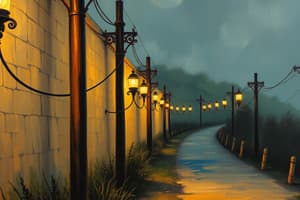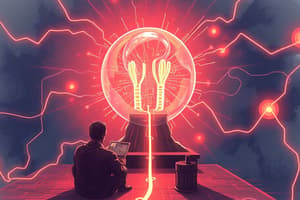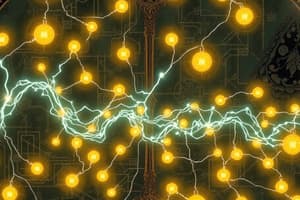Podcast
Questions and Answers
What are the four key properties of electricity?
What are the four key properties of electricity?
Current, voltage, resistance, and power.
Who created Ohm's Law?
Who created Ohm's Law?
Georg Simon Ohm.
What does the unit 'Amperes' measure?
What does the unit 'Amperes' measure?
Current.
What does 'Voltage' refer to?
What does 'Voltage' refer to?
Who formulated Coulomb's Law?
Who formulated Coulomb's Law?
The flow of electricity can be divided into two types: _____ and _____ current.
The flow of electricity can be divided into two types: _____ and _____ current.
Direct Current (DC) is commonly used in power supplies like outlets.
Direct Current (DC) is commonly used in power supplies like outlets.
Which of the following are examples of passive electrical components?
Which of the following are examples of passive electrical components?
Match the following components with their function:
Match the following components with their function:
What is the function of a fuse in an electrical circuit?
What is the function of a fuse in an electrical circuit?
Which component converts electrical energy to mechanical energy?
Which component converts electrical energy to mechanical energy?
What does a potentiometer do?
What does a potentiometer do?
The tolerance value of a resistor indicates the range of variability in its resistance.
The tolerance value of a resistor indicates the range of variability in its resistance.
Flashcards are hidden until you start studying
Study Notes
Electricity Basics
- Electricity arises from the movement of electrons between atoms, essential for electrical devices' operation.
- Key properties include current, voltage, resistance, and power.
Ohm’s Law
- Created by Georg Simon Ohm to establish the relationship between voltage, current, and resistance.
- Current is measured in Amperes (A); a current of 0.5 A can cause electric shock.
- Voltage, measured in Volts (V), is the force that drives electron flow; Alessandro Volta invented the first battery.
- Resistance is measured in Ohms (Ω); it opposes current flow, as described by Ohm.
Charge and Power
- Charge, measured in Coulombs (C), represents the amount of charge passing through a conductor.
- Coulomb’s Law states the force between charges is proportional to the product of their magnitudes and inversely proportional to distance.
- Power, measured in Watts (W), signifies the rate of doing work; James Watt is known for his steam engines.
Units of Measurement
- Kilo (k) = 1,000
- Mega (M) = 1,000,000
- Milli (m) = 1/1,000
- Micro (µ) = 1/1,000,000
- Nano (n) = 1/1,000,000,000
- Pico (p) = 1/1,000,000,000,000
Circuit Types
- Electrical Circuits: High power consumption, includes resistors, inductors, capacitors.
- Electronic Circuits: Utilize semiconductors, lower power consumption, used for data processing.
Types of Current
- Alternating Current (AC): Electrons oscillate back and forth; commonly used in power outlets.
- Direct Current (DC): Electrons move in one direction; commonly found in battery-operated devices.
Components of Circuits
- Active Components: Deliver power (e.g., diodes, transistors). Control current, produce energy, and are energy donors.
- Passive Components: Use energy (e.g., resistors, capacitors). Store energy and are energy acceptors.
Circuit Diagrams
- Circuit Diagram: Realistic images of components.
- Schematic Diagram: Standardized symbols to simplify circuit functionality.
Important Components
- Transistors: Control current flow and amplify signals.
- Resistors: Limit current flow and adjust voltage.
- Inductors: Store energy in a magnetic field.
- Capacitors: Store energy in an electric field, smooth out voltage fluctuations.
- Breadboard: Used for prototyping; connects components via conductive material.
Conductivity Ranking
- Silver: Most conductive, followed by Gold, then Copper (most commonly used).
Power Supply
- Converts electrical current into the required voltage and frequency.
- Includes cells, batteries, and transformers.
Additional Components
- Ground/Earth: Enhances safety and stability.
- Fuse: Breaks the circuit in case of overload.
- Transformer: Adjusts voltage levels as needed.
Output Devices
- Transducers: Convert energy forms (e.g., electrical to mechanical).
- Lights and Motors: Convert electrical energy to other forms like light and mechanical energy.
Types of Switches
- Push to Break: Used in timers and alarms.
- Single-Pole, Single-Throw: Controls one device.
- Double-Pole, Single-Throw: Dual switch for mains electricity.
Resistors
- Fixed Resistors: Have a fixed resistance value.
- Variable Resistors: Adjustable resistance (e.g., potentiometer).
Resistor Color Code
- Indicates resistance through color bands indicating digits and tolerance.
Capacitors
- Two-terminal components with metal plates and an insulating dielectric.
Transistors
- Control electron movement; types include Bipolar Junction Transistors (BJT) and Field Effect Transistors (FET).
- NPN and PNP transistors comprise different semiconductor configurations.
Meters
- Ammeter: Measures current.
- Voltmeter: Measures voltage.
- Ohmmeter: Measures resistance.
- Galvanometer: Measures small currents.
Studying That Suits You
Use AI to generate personalized quizzes and flashcards to suit your learning preferences.




